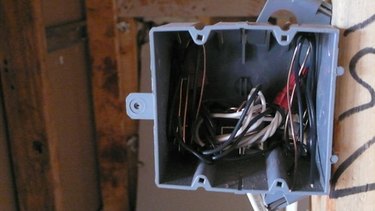
The National Electrical Code (NEC) mandates specific sizes for pull boxes, determined primarily by the conduit, or raceway, sizes and pulling scheme. Three types of pulling schemes are used: Straight-pulls, which travel straight through a pull box; angle-pulls, which make a 90 degree angle; and U-pulls, which turn 180 degrees to re-enter the same side wall. When pull boxes contain multiple rows of conduit entries and schemes, each is calculated separately and the largest calculation should be used to determine the pull box size.
Straight-Pulls
Video of the Day
Step 1
Measure or reference the size of the largest raceway or conduit.
Video of the Day
Step 2
Multiply the largest raceway size by eight.
Step 3
Use a pull box with a minimum distance between raceways as the figure you calculated. As an example, a 3-inch raceway multiplied by eight results in a minimum distance of 24 inches between raceways . No other measurement is stipulated.
Angle-Pulls
Step 1
Measure or reference the size of the largest raceway of the angle-pull. Also measure the sizes of any other raceways entering the same wall.
Step 2
Calculate the minimum pull box width as six times the largest raceway size, plus the sum of all other raceways entering the same wall. As an example, a 3-inch raceway pull with another 2-inch raceway entering the same wall would be calculated as six times 3 inches plus 2 inches which results in a minimum width of 20 inches.
Step 3
Calculate the minimum height of the pull box using the same formula as the width. In the example, the minimum height would also be 20 inches.
Step 4
Calculate the minimum distance between raceways, which are part of the same pull, as six times the largest raceway. In the example, six times 3 inches results in a minimum spacing of 18 inches.
U-Pulls
Step 1
Measure or reference the size of the largest raceway or conduit.
Step 2
Calculate the minimum distance between the entry wall and the opposite wall as six times the largest raceway size plus the sum of all other raceways entering the same wall. As an example, a 3-inch raceway U-pull with another 2-inch raceway entering the same wall would be calculated as six times 3 inches plus 2 inches, which results in a minimum distance between the entry and opposite walls of 20 inches.
Step 3
Calculate the minimum distance between raceways by multiplying the largest raceway by six. In the example, a 3-inch raceway multiplied by six results in a minimum spacing of 18 inches between raceways.